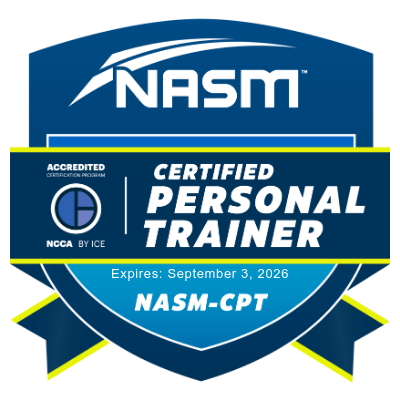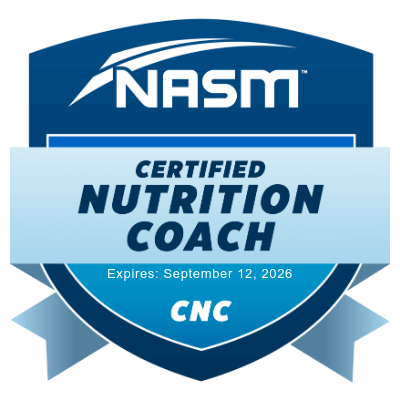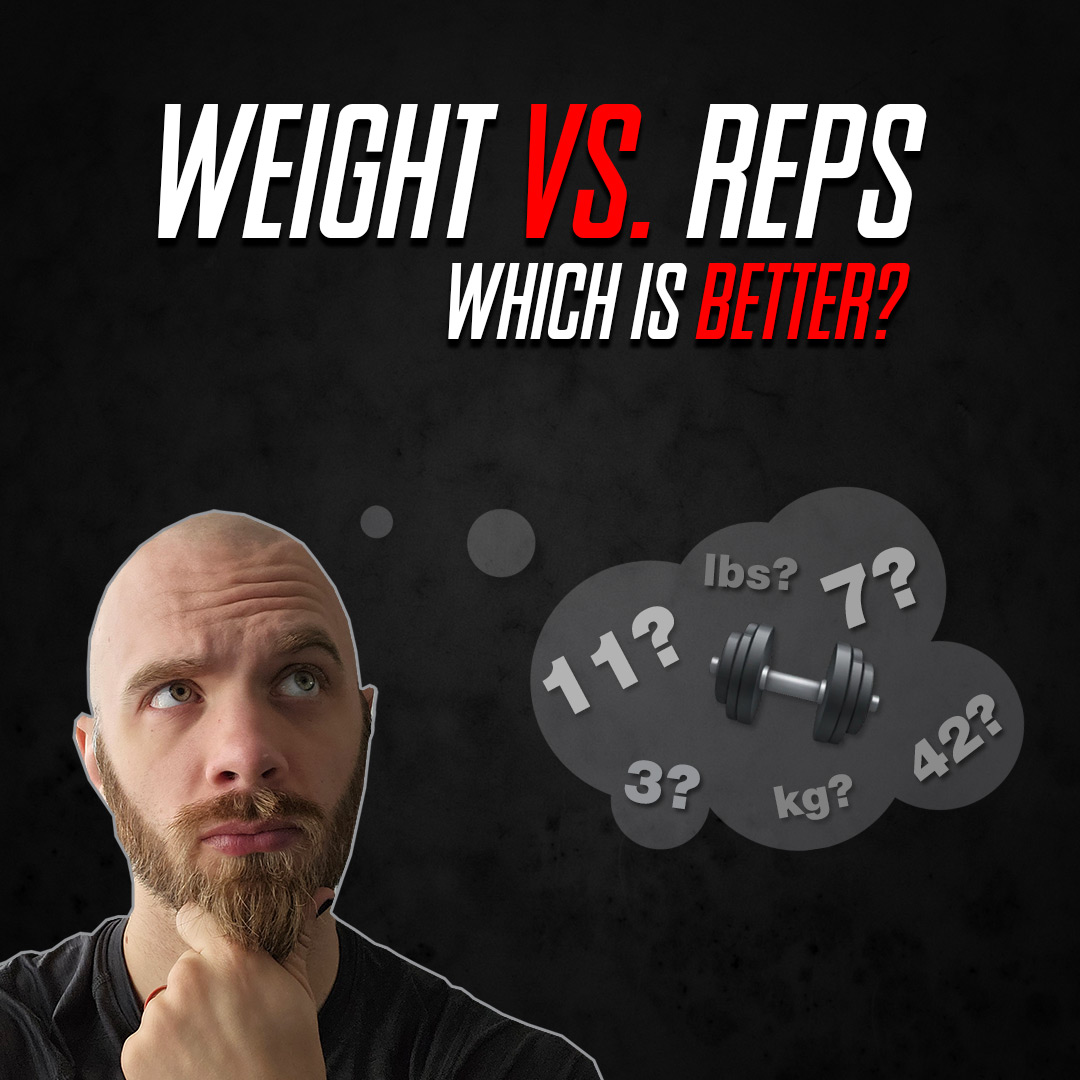
One of the most common questions I get asked is: Should I lift more weight or do more reps? Well, like an elderly incontinent gentleman might say if you ask what he’s wearing: it depends. Okay, I’m scraping the bottom of the barrel for jokes, but this article is solid. Read on!
In this article…
- The Purpose of Increasing Weight Or Reps
- What Is Progressive Overload?
- Strength, Hypertrophy, or Endurance?
- Just Tell Me Already, Reps or Weight?
- Should I Lift To Failure?
- So No Cheat Reps, No Lifting To Failure? Period?
- The Hybrid Approach
The Purpose Of Increasing Weight Or Reps
Many people ask which of the two variables (weight or reps) they should increase on any given exercise, but rarely ask why.
Weight and repetitions are only two variables used to increase the difficulty of an exercise. We can also adjust our stance, lower our rest between sets, change angles for different leverage, or switch exercises altogether. So why change weight, reps, or any other variable?
The answer is, generally, to achieve progressive overload.
What Is Progressive Overload?
In short, it’s a concept that promotes consistent growth by keeping a task challenging. If the task you’re training, let’s say Cossack squats, isn’t difficult for you then you are unlikely to get better. If you don’t change variables, your body will adapt to the current stress and eventually plateau.
Think of it like this: let’s say you teach a child to play chess. For a good long while, you’re gonna destroy them. They’re small and dumb so they fall victim to your Sokolsky Opening every time.
Little idiot.
It’s so easy that you can purposely make illogical moves and still drink their tears at the end of the match.
You are not improving during this time.
But you know what? That kid is learning a lot.
Why?
Because they are clearly outmatched, and therefore the task is challenging to them. Their brain is firing on all cylinders and their neuroplasticity is being put to the test. With time, that kid is going to trap you in a Nimzowitsch Defence you forgot even existed. Then you will be humbled.
This is why it is important to always challenge yourself every opportunity you get.
In the field of fitness, variables like weight and reps are some of our tools to accomplish this. So the next thing you need to consider are your goals. Generally speaking, our goals will align with one of three categories: strength, hypertrophy, or endurance.
Strength, Hypertrophy, or Endurance?
When lifting weights we have three primary goals:
Raw Strength – This is our ability to produce maximal force. These adaptations are largely neurologic, meaning our brain re-wires our nerves to send stronger signals and recruit more muscle fibers for a given task. A popular example of a lifter who prioritizes this is Anatoly.
Muscular Hypertrophy – This is a fancy way to say ‘build muscle’, in the traditional body builder sense. We are still gaining strength, but primarily stimulating the growth of new muscle fibers to pack on extra tissues for size and aesthetics. With additional muscle comes strength, of course, but you don’t NEED giant muscles to be strong, as Anatoly showed us above.
It’s important to note that many professional body builders are also on massive amounts of steroids to achieve their desired aesthetic, and training within the hypertrophy range will not make you look like them.
Unless you also take steroids.
Muscular Endurance: The final adaptation we strive for is muscular endurance. This is your ability to maintain a certain output for an extended period of time. Again, you can still get strong as hell with this kind of training, but the focus is different.
Instead of re-wiring things or building more tissues, we focus on making our energy systems more efficient.
My favorite example of this kind of athlete is Alex Honnold, a rock climber who scaled the 3,200 feet tall El Capitan mountain in Yosemite National park without any safety gear.
Whichever goal we pursue will dictate the rep / weight scheme for a particular exercise.
Just Tell Me Already, Reps Or Weight?
The short answer is reps.
Think of repetitions as a sliding scale, shown below:

As you can see, on the far left we have strength at 1-5 reps, in the middle we have hypertrophy at 6-12, and passed 13 reps we have endurance.
You may have also noticed there are no weight suggestions on this scale.
Calm down, this is intentional.
Example Situation A
Let’s say our goal is raw strength. This means I need to pick a weight for my chosen exercise (Cossack squat, kettlebell halo, deadlift, etc.) that is challenging for me in the 1-5 rep range.
An example:
Jim, our example gym rat, grabs a 30lb dumbbell off the rack and curls it twelve times. Since his goal is to increase raw strength, this is too light. He goes back, grabs a 40lb dumbbell and curls it nine times.
Still too light.
He grabs a 50lb dumbbell and curls it three times before his reps look like crap and he has to start rocking his body to finish the rep.
This is now Jim’s working weight: 50lb on a dumbbell curl.
Over the next few weeks, Jim will curl this 50lb dumbbell for three to four sets until he can (with excellent form) curl six or seven reps per set. Once that happens, he’ll up the weight to 55lbs, so his rep range is below five again.
This will accelerate his strength gains faster than the other rep ranges, since raw strength is his current goal.
Example Situation B
Now let’s say Jim wants to increase his muscular endurance for the same exercise. He’s preparing for a protein shake chugging competition and needs to be able to curl light to moderate weight for an hour or something.
Just go with it.
This requires different stimulus than raw strength output, which is what we trained before.
He obviously can’t curl 55lbs for 13+ reps, so he’ll have to lower the weight back down to 30lbs for his training. He’ll bang out 3-4 sets at 13+ reps for the next few weeks and win his competition.
By lowering the weight and changing the rep range, Jim has prioritized a new set of adaptations.
Side Note:
In case it wasn’t clear, the key factor here is that each set is challenging and brings you close to failure within the rep range of your chosen goal.
If you’re used to curling 55lb dumbbells for 5 reps, then picking up a 10lb dumbbell and also curling it for 5 reps will not yield results.
Should I Lift To Failure?
To failure, or not to failure: that is the question.
Lifting to failure generates a TON of fatigue, especially to untrained lifters. It could also be dangerous, depending on the exercise.
If we’re bench pressing 400lbs and bring each set to exhaustive failure, there’s a good chance we’ll drop the bar and decapitate ourselves. My professional advice is to NOT decapitate yourself, as this tends to slow your progress.
But there’s a difference between exhaustive failure and technical failure.
Exhaustive failure is when we physically cannot move the weight any more. Our muscles and nervous system flip us the bird 🖕 and prevent any further movement.
Technical failure is when we cannot move the weight without cheating on form. We start to rock the weight, do partial reps, blurt expletives for extra power, or something like that.
Personally, once I achieve technical failure the set is over. I prefer clean, controlled reps throughout my sets for a few main reasons:
- Less fatigue.
- Less risk of injury.
- Clearer demonstration of progress.
Generating less fatigue is almost always a good thing. Fatigue is cumulative, so if I can get the same gains and feel better doing it then I win.
Less risk of injury is an obvious bonus because being injured sucks.
Clearer demonstration of progress is important to me because I’m a nerd and like to track all my workouts. If I’m cheating on reps or letting them get sloppy, my numbers will be more erratic and less reliable.
They’re also simply a lie.
Cheat reps are ego reps, they make you feel better but they don’t improve your gains.
So No Cheat Reps, No Lifting To Failure? Period?
My professional opinion is to avoid cheat reps or ego lifting of any kind, and lift to failure only sparingly.
When?
Maaaybe the last set of an exercise, since you know you’re almost done and won’t need the energy for later. Even then, I’d do it maaaybe once a mesocycle. Like, your last few workouts before a deload you can go HAAM and squeeze out any last little gains because you know you’re going to rest.
With adequate rest in sight, additional fatigue isn’t as detrimental.
As far as cheat reps are concerned, they are mostly useless. If you’re a body builder and want to do partial reps to increase blood flow to a specific muscle then that’s fine, but realize they don’t count as working sets.
The Hybrid Approach
Using the sliding scale above, I want you to realize that these numbers are not set in stone. It’s not like if you lift exactly 5 reps you’re in the optimal strength zone and as soon as you dip into 6 reps you’re magically inducing hypertrophy.
They all work in tandem, the scale just gives you an idea of what your results will be. This means if you want to build raw strength and still pack on a bit of extra size, somewhere between 4-8 reps is ideal. If you’re looking to chisel your muscles and increase their endurance, maybe you shoot for 10-14 reps.
Personally, I like staying in the strength / hypertrophy zone and increase my weight once I hit 7-8 reps on a given exercise. This means at the beginning of the cycle I’m gaining raw strength / power, and later into the cycle I’m building additional muscle tissue to support the weight increase down the road.
I’m not really going for size, since I need to stay lean and mobile for jiu-jitsu. But I still get aesthetic and performance improvements while not feeling like I got hit by a bus after each training session.








